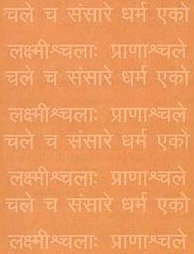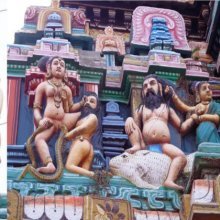Tripundra, Tripuṇḍra, Tri-pundra, Tripumdra: 15 definitions
Introduction:
Tripundra means something in Hinduism, Sanskrit, Marathi. If you want to know the exact meaning, history, etymology or English translation of this term then check out the descriptions on this page. Add your comment or reference to a book if you want to contribute to this summary article.
Images (photo gallery)
In Hinduism
Purana and Itihasa (epic history)
Source: archive.org: Shiva Purana - English TranslationTripuṇḍra (त्रिपुण्ड्र) or Tripuṇḍraka refers to the “three parallel lines of ash marks over the forehead”, according to the Śivapurāṇa 1.18. Accordingly, “[...] the Tripuṇḍraka (the three parallel lines of ash marks over the forehead) is the essence of Trinity: Brahmā, Viṣṇu and Rudra. Similarly Maheśvara has retained the esence of everything in the form of Tilaka (the small circular mark) on the forehead. [...] Ashes (bhasma) must first be smeared in the dust form and then in the Tripuṇḍraka form. At the time of worship water is added to the ashes. For mere sanctification the ashes are used without water”.
Tripuṇḍra is preferably made of ashes from dry cow-dung or from ashes resulting from Agnihotra, according to the Śivapurāṇa 1.24, while explaining the importance of holy ashes (bhasma):—“[...] in the different parts of the body as the forehead etc. three lines constitute the Tripuṇḍra. The Tripuṇḍra on the forehead extends from the middle of the eyebrows to the tips of the brows on either side. With the middle and the ring fingers a line drawn in the opposite direction is called Tripuṇḍra. With the three middle fingers, take the ashes and apply the Tripuṇḍra on the forehead. It would give worldly pleasures and salvation”.
For each of the three lines there are nine deities everywhere in the body. I shall mention them. Listen attentively.
The nine deities of the first line are:—The syllable “A”, Gārhapatya fire (sacrificial fire), Earth, Dharma, the attribute Rajas, Ṛgveda, Kriyāśakti (the power to do), Prātaḥsavana (morning rituals) and Mahādeva. [...]
The nine deities of the second line are:—The syllable “U”, Dakṣiṇā fire (sacrificial fire), the principle of Ether, Attribute Sattva, Yajurveda, Mādhyandina Savana midday rituals), Icchāśakti (the will-power), the Antarātman (the immanent soul) and Maheśvara. [...]
The nine deities of the third line are:—The syllable “M”, Āhavanīya (sacrificial) fire, the supreme soul, the attribute Tamas, heaven, Jñāna Śakti, Sāmaveda, the third Savana (evening rituals) and Śiva. [...]
Thus making obeisance to the deities of the different parts with devotion, one shall apply the Tripuṇḍra. One will become pure and derive worldly pleasures and salvation.
Source: Cologne Digital Sanskrit Dictionaries: The Purana IndexTripuṇḍra (त्रिपुण्ड्र).—A mark on the forehead.*
- * Brahmāṇḍa-purāṇa IV. 38. 22.

The Purana (पुराण, purāṇas) refers to Sanskrit literature preserving ancient India’s vast cultural history, including historical legends, religious ceremonies, various arts and sciences. The eighteen mahapuranas total over 400,000 shlokas (metrical couplets) and date to at least several centuries BCE.
Vedanta (school of philosophy)
Source: Shodhganga: Siva Gita A Critical StudyTripuṇḍra (त्रिपुण्ड्र) refers to “three marks”.—The Śaivaite sectarian mark, consisting of three horizontal lines of vibhūti (holy ash) above the brow, often with a dot (bindu) at the third eye. The three lines represent the soul’s three bonds: āṇava, karma and māyā.

Vedanta (वेदान्त, vedānta) refers to a school of orthodox Hindu philosophy (astika), drawing its subject-matter from the Upanishads. There are a number of sub-schools of Vedanta, however all of them expound on the basic teaching of the ultimate reality (brahman) and liberation (moksha) of the individual soul (atman).
General definition (in Hinduism)
Source: Academia.edu: A New Public TheologyTripuṇḍra (त्रिपुण्ड्र, “three stripes of ash”):—Śaivas in Nīlakaṇṭha’s day, as they do at present, commonly applied to their foreheads three stripes of ash known as the tripuṇḍra. It is also stated in the Merutantra: “The tripuṇḍra with fragrant sandal paste for devotees of Siva accompanied by the goddess.”
Languages of India and abroad
Marathi-English dictionary
Source: DDSA: The Molesworth Marathi and English Dictionarytripuṇḍra (त्रिपुंड्र).—m n S Three horizontal lines drawn on the forehead with ashes by the smārtta sect (worshipers of śiva): also three vertical lines drawn with gōpī- candana or chalk by the vaiṣṇava sect (worshipers of viṣṇu): also attrib. bearing upon the forehead these distinctive or sectarial lines.
Source: DDSA: The Aryabhusan school dictionary, Marathi-Englishtripuṇḍra (त्रिपुंड्र).—m n Three horizontal lines drawn on the forehead with ashes by the smārta sect; also three vertical lines drawn with gōpīcandana or chalk by the vaiṣṇava sect. a Bearing upon the forehead these distinctive or sectarial lines.
Marathi is an Indo-European language having over 70 million native speakers people in (predominantly) Maharashtra India. Marathi, like many other Indo-Aryan languages, evolved from early forms of Prakrit, which itself is a subset of Sanskrit, one of the most ancient languages of the world.
Sanskrit dictionary
Source: DDSA: The practical Sanskrit-English dictionaryTripuṇḍra (त्रिपुण्ड्र).—a mark on the forehead consisting of three lines made with cowdung ashes.
Derivable forms: tripuṇḍram (त्रिपुण्ड्रम्).
Tripuṇḍra is a Sanskrit compound consisting of the terms tri and puṇḍra (पुण्ड्र). See also (synonyms): tripuṇḍraka.
Source: Cologne Digital Sanskrit Dictionaries: Shabda-Sagara Sanskrit-English DictionaryTripuṇḍra (त्रिपुण्ड्र).—n.
(-ṇḍraṃ) Three curved horizontal marks, made across the forehead with cowdung, &c.; they are worn especially by the followers of Siva, or Sakti, and are indispensable in proceeding to worship the former. E. tri three, triple, and puṇḍra a line; also with kan added tripuṇḍraka .
Source: Cologne Digital Sanskrit Dictionaries: Benfey Sanskrit-English DictionaryTripuṇḍra (त्रिपुण्ड्र).—n. three horizontal marks made across the forehead, especially by the followers of Śiva.
Tripuṇḍra is a Sanskrit compound consisting of the terms tri and puṇḍra (पुण्ड्र).
Source: Cologne Digital Sanskrit Dictionaries: Cappeller Sanskrit-English DictionaryTripuṇḍra (त्रिपुण्ड्र).—[neuter] three lines made across the forehead and other parts of the body with ashes etc., [especially] by the followers of Śiva.
Source: Cologne Digital Sanskrit Dictionaries: Monier-Williams Sanskrit-English DictionaryTripuṇḍra (त्रिपुण्ड्र):—[=tri-puṇḍra] [from tri] n. a triple sectarial mark consisting of 3 lines or marks on the forehead (or on back, heart, shoulders etc., [Religious Thought and Life in India 400]), [Vasiṣṭha; Harivaṃśa; Brahmāṇḍa-purāṇa; Tithyāditya]
Source: Cologne Digital Sanskrit Dictionaries: Yates Sanskrit-English DictionaryTripuṇḍra (त्रिपुण्ड्र):—[tri-puṇḍra] (ṇḍraṃ) 1. n. Three curved horizontal marks on the forehead.
[Sanskrit to German]
Sanskrit, also spelled संस्कृतम् (saṃskṛtam), is an ancient language of India commonly seen as the grandmother of the Indo-European language family (even English!). Closely allied with Prakrit and Pali, Sanskrit is more exhaustive in both grammar and terms and has the most extensive collection of literature in the world, greatly surpassing its sister-languages Greek and Latin.
Kannada-English dictionary
Source: Alar: Kannada-English corpusTripuṃḍra (ತ್ರಿಪುಂಡ್ರ):—[noun] the three strips marked horizontally on the forehead with sacred ashes, as a sectarian mark.
Kannada is a Dravidian language (as opposed to the Indo-European language family) mainly spoken in the southwestern region of India.
See also (Relevant definitions)
Starts with: Tripundradharanavidhi, Tripundradhari, Tripundraka, Tripundramahatmya.
Full-text (+3): Tripundraka, Tripundrin, Tiripuntaram, Tripundarikrita, Tripundradhari, Pattavardhana, Rishikanya, Tritiyasavana, Shivashrami, Pratahsavana, Shvetashvatara, Madhyandinasavana, Nagakanya, Citrasana, Kaupina, Mrigacarma, Kashtha, Pashupatayoga, Dharya, Brahma.
Relevant text
Search found 14 books and stories containing Tripundra, Tripuṇḍra, Tri-pundra, Tri-puṇḍra, Tripumdra, Tripuṃḍra; (plurals include: Tripundras, Tripuṇḍras, pundras, puṇḍras, Tripumdras, Tripuṃḍras). You can also click to the full overview containing English textual excerpts. Below are direct links for the most relevant articles:
The Devi Bhagavata Purana (by Swami Vijñanananda)
Chapter 12 - On the greatness in holding the Tripuṇḍra and Bhaṣma < [Book 11]
Chapter 13 - On the greatness of Bhasma < [Book 11]
Chapter 11 - On the description of the greatness of the three kinds of Bhaṣmas < [Book 11]
The Shiva Purana (by J. L. Shastri)
Chapter 21 - Nitya and Naimittika rites < [Section 7.2 - Vāyavīya-saṃhitā (2)]
Chapter 24 - The greatness of the holy ashes (bhasma) < [Section 1 - Vidyeśvara-saṃhitā]
Chapter 9 - Śiva’s incarnations as Yogācāryas < [Section 7.2 - Vāyavīya-saṃhitā (2)]
Hindu Pluralism (by Elaine M. Fisher)
The Practical Applications of Textual Criticism < [Chapter 3 - Constructing Sectarian Identities in Early Modern South India]
Śaṅkarācārya Worships the Goddess < [Chapter 2 - The Making of the Smārta-Śaiva Community of South India]
Śrīvidyā and society in Nīlakaṇṭha Dīkṣita’s Saubhāgyacandrātapa < [Chapter 2 - The Making of the Smārta-Śaiva Community of South India]
Shaiva Upanishads (A Critical Study) (by Arpita Chakraborty)
19. Rules relating to the Tripuṇḍra < [Chapter 2 - Greatness of Bhasma and Dhāraṇa]
6. Wearing of the Tripuṇḍra Mark in early morning < [Chapter 2 - Greatness of Bhasma and Dhāraṇa]
28a. Kālāgnirudra on Triśakti and Mṛtyuñjaya Mantras < [Chapter 2 - Greatness of Bhasma and Dhāraṇa]
The Skanda Purana (by G. V. Tagare)
Chapter 16 - Efficacy of the Holy Ash (Continued) < [Section 3 - Brāhmottara-khaṇḍa]
Chapter 2 - The Application of Tripuṇḍra < [Section 5 - Mārgaśīrṣa-māhātmya]
Chapter 20 - The Great Efficacy of Rudrākṣa: The Story of Mahānandā < [Section 3 - Brāhmottara-khaṇḍa]
Rudra-Shiva concept (Study) (by Maumita Bhattacharjee)
2. Rudra-Śiva in the Upaniṣadic Literature < [Chapter 4 - Rudra-Śiva in the Post-Brāhmaṇic Literature]
Related products

